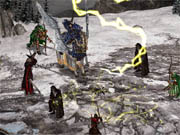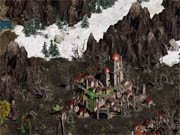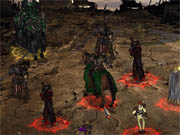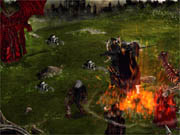Fantasy settings are a dime a dozen in gaming--things such as fire-breathing dragons and wizards with flowing beards and pointy hats have long since become clichés. After all, despite how many games take place in fantasy realms, very few of them--for various reasons--manage to use these settings effectively. Yet the success of the recent film The Lord of the Rings is a reminder that fantasy, when done right, can be cool. Disciples II: Dark Prophecy is further proof of this--it's one of those very rare computer games that draws on all the usual fantasy conventions but presents them in truly inspired, artistic form. However, the visuals aren't the only good thing about Disciples II. This turn-based strategy game, an overdue sequel to Strategy First's sleeper hit released back in August of 1999, has an elegant simplicity about it.

Disciples II takes place not long after the events of the original, and as such, the same four factions are the focus. These include the Empire, a sect of mighty human warriors; the Mountain Clans, a stalwart group of ancient dwarves; the Undead Hordes, restored to unnatural life thanks to the twisted magic of their queen; and the Legions of the Damned, literally demons from hell. The latter two perhaps sound more appealing, and to some extent they are, since it's always fun to play as the bad guy--especially bad guys as fearsome and evil as the undead and the demons of Disciples II. But all the factions are equally appealing in their own right, and while they all basically play the same way, each side has its own wide variety of great-looking, powerful units for you to use.
It's easy to get started playing Disciples II, but no thanks to the sparse manual and well-hidden, lackluster in-game tutorial. Like in the original, the core gameplay and mechanics of Disciples II are superficially similar to those of New World Computing's popular Heroes of Might and Magic series, since scenarios all take place on densely detailed isometric maps filled with treasure, wandering monsters, and plenty of places to explore. The game's resolution is locked at 800x600, and the maps are so concentrated that it can often be difficult to see some of their important features--for instance, you might overlook a powerful enemy squad that's practically in plain view. A minimap is always onscreen to help give you a better sense of the surroundings, but the game's fixed resolution keeps it from being particularly useful. However, you'll soon grow accustomed to the cluttered appearance of the maps as you scour each one using small yet mighty squads led by hero characters that you'll recruit from your castle.
You will spend little time building up your castle and will usually be occupied with more adventurous things, such as exploring and battling your foes. Resource management is important but thankfully simple. Each turn in Disciples II corresponds to a day of game time, and each passing day, the land surrounding your castle or any towns you've captured expands to encompass any nearby resources. These include gold that's used for buying new structures and items, as well as four different types of mana that are used for casting various spells. You can tell when you're on the home turf of any of the factions--the Empire's lands are lush and green, the Mountain Clans' areas are covered in snow, desolate wastelands are home to the Undead Hordes, and molten fissures in the earth are the trademark of the Legions of the Damned.
Each day, you can build a new structure in your castle, most of which are used to unlock higher-level versions of your units. You can't just recruit these--you must earn them by gaining enough battlefield experience with the basic unit. Your forces will engage in battles frequently, as most maps are filled with hostiles and are well balanced to include plenty of weaker foes near your starting location but much stronger foes farther out. Since all your units gain experience levels individually, you'll have to learn to pick your battles carefully and make sure you can keep your forces alive long enough to level up. This should all be familiar territory for Disciples players.

In fact, aside from the completely redone graphics and sound, there aren't many immediately noticeable differences between the sequel and the original. Just about every single unit from the first game returns intact in the sequel, though you'll find that some unit balance issues have been fine-tuned. The resource model is the same, spellcasting is the same (as are most all of the spells), the role of thief units is the same, and the ability to choose from three different leader classes remains the same as well. That is, if you're familiar with Disciples, you'll be able to dive right into the sequel.
If you're not, you may be wondering about those three leader classes. You can play as a warrior lord, mage lord, or guildmaster lord--respectively, these options predispose your forces to focusing more on brute force, magic, or subterfuge. All the choices are viable--the warrior lord is the easiest route to take, the mage lord is strongest late in the game, and the guildmaster is the most interesting of the three. Each faction has access to a thief unit capable of spying on his foes, but as a guildmaster, your thieves will have exclusive access to various useful abilities. They'll be able to assassinate weaker foes outright or make other covert actions like send counterfeit orders to an enemy group, forcing it to rearrange in a random formation that might place its most vulnerable units in the front line.
Despite the epic theme and style of Disciples II, you actually control a relatively small number of units. Disciples II's battles between small yet powerful groups of characters give it more the sense of a role-playing game than of a typical strategy game, as you'll become attached to your individual units as they gradually gain experience and grow in power. You'll become attached to them partly because leveling up your units requires a lot of care and effort, so you probably won't have more than several heroes doing most of the work in any given scenario. You actually won't have much choice, because once you've killed all those low-level creatures, they're gone for good--any new heroes you hire will be hard-pressed to find a fair fight. For better or worse, this means you'll likely end up loading saved games a lot in Disciples II--you can't afford to let your strongest hero be killed in action. Loading saved games is painless, and a convenient auto-save feature makes a record of your progress after every turn.

You don't gain experience levels often, but when you do, there's a big payoff--so much that the act of fighting monsters to gain experience becomes a very addictive part of the game. Your hero will be able to learn a new skill of your choice, aside from becoming stronger and tougher. But your other units will transform into brand-new units when they level up. For instance, an Imperial squire will become a knight--or alternately, a witch hunter, who has slightly fewer hit points than the knight but is completely immune to fear and paralysis effects. There are multiple, mutually exclusive upgrade options for each basic unit type--once you've chosen one path over another, you've committed yourself to that path through the duration of the scenario. Making these choices can be tough, but it's part of the fun.
Almost all the new units in Disciples II are extremely strong high-level units--units with suitable names such as holy avenger, forge guardian, dracolich, and abyssal devil--that broaden the branching upgrade options for each faction. Each side now has about 30 different units in all. The new units help make some of the oft-neglected units from Disciples much more viable, as there may be an enticing, new unit upgrade to look forward to. Also, unlike the original, Disciples II doesn't have a restrictive level cap, so even after you've fully upgraded your forces, you can keep gaining levels to further improve their strength.
In general, combat in Disciples II is resolved quickly and uses extremely simple yet fun turn-based mechanics, which offer tactical depth but also a healthy bit of randomness to keep fights from being too predictable. Four difficulty settings are available, and at the default setting, the computer makes a worthy, cunning opponent--it will almost always fight smart and will focus its wrath on your most important, most vulnerable, or most injured units. Controlling the action both during and outside of combat is perfectly intuitive when you're using just the mouse--you can always right-click to bring up detailed information about whatever the cursor happens to be pointing at.
In Disciples, characters could either attack or skip their turn, and that was it. Disciples II adds the ability to defend, which makes the unit take half the damage from any attacks until its next turn, as well as the option for a unit to wait until the end of a round before acting. Furthermore, hero units can now equip up to two different items before going into battle--items like healing potions or magical artifacts--and can elect to use the equipped items during their turns. These aren't drastic changes, but they help make Disciples II's combat system better than the first game's. The new options aren't so complicated that they threaten the deliberate simplicity of the combat system, but they do make the combat more tactical and more enjoyable.
The modes of play in Disciples II are the same as those in the first game. You'll be able to lead any of the factions in its own lengthy "saga," a campaign comprising a number of linked scenarios that collectively tell the game's story from four perspectives. The sagas are engaging and challenging, but not especially flashy--though narrated cinematic montages are used to introduce each new scenario, the story unfolds merely through pop-up text during gameplay. Disciples II also offers about 20 stand-alone "quests," which are individual scenarios that can be played in any order.
A fully featured scenario editor is included with the game, and it lets you create your own maps, custom units, and much more. It includes a relatively easy-to-use event trigger system that actually lets you create rather complex cause-and-effect situations in your maps. Since Disciples II already has a fan following, it's reasonably safe to expect a lot of good scenarios to come out of the player community. Disciples II is ideally suited as a single-player game--most of its numerous scenarios can take hours to finish--but multiplayer options are available. You can play against fellow humans in a hot seat mode, over a LAN, or over the Internet.

Disciples II's gorgeous graphics are clearly a labor of love. The stylized, hand-painted portraits of each unit are generally very well done, and many of the prerendered units you see during battle are smoothly animated and very impressive. Great strategy games don't necessarily need great graphics--but Disciples II is evidence that great graphics never hurt; in fact, they really enrich the experience here. The audio is generally good too, though some of the unit acknowledgements sound a bit awkward and aren't quite as memorable as some of the stuff from the first game. On the other hand, the musical score fits very well, subtly adding to the game's epic quality.
It's true that Disciples II doesn't really do much that hasn't been done before in other fantasy-themed turn-based strategy games, particularly its own predecessor. Yet the game's unique style and great gameplay, with its distilled strategic and tactical elements, makes for a very enjoyable experience--one that can last you for a very long time. If you were fortunate to have played the original Disciples, you'll find the sequel to be similar but ultimately superior to the first. Meanwhile, those who haven't played Disciples before, and even those who haven't played many turn-based strategy games before, are likely to enjoy the accessible, attractive Disciples II at least as much as fans of its predecessor will.